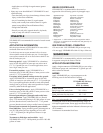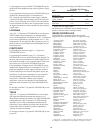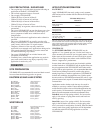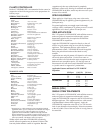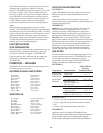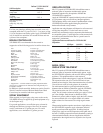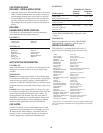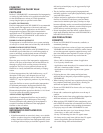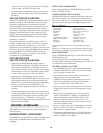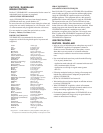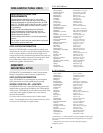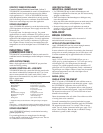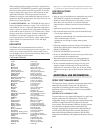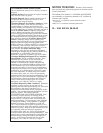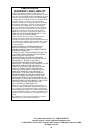
CONTROLLING DROPLET SIZE
- GENERALTECHNIQUES
•Volume - Use high flow rate nozzles to apply the highest
practical spray volume. Nozzles with higher rated flows
produce larger droplets.
• Pressure - Use the lower spray pressures recommended for the
nozzle. Higher pressure reduces droplet size and does not
improve canopy penetration. When higher flow rates are
needed, use a higher-capacity nozzle instead of increasing
pressure.
• Nozzle Type - Use a nozzle type that is designed for the
intended application. With most nozzle types, narrower spray
angles produce larger droplets. Consider using low-drift
nozzles.
CONTROLLING DROPLET SIZE - AIRCRAFT
• Number of Nozzles - Use the minimum number of
nozzles with the highest flow rate that provide uniform
coverage.
• Nozzle Orientation - Orienting nozzles so that the spray is
emitted backwards, parallel to the airstream will produce
larger droplets than other orientations.
• Nozzle Type - Solid stream nozzles (such as disc and core
with swirl plate removed) oriented straight back produce
larger droplets than other nozzle types.
BOOM LENGTH AND HEIGHT
• Boom Length (aircraft) - The boom length should not
exceed 3/4 of the wing length, using shorter booms decreases
drift potential. For helicopters use a boom length and position
that prevents droplets from entering the rotor vortices.
• Boom Height (aircraft) - Application more than 10 feet
above the canopy increases the potential for spray drift.
• Boom Height (ground) Setting the boom at the lowest
labeled height (if specified) which provides uniform coverage
reduces the exposure of droplets to evaporation and wind.
The boom should remain level with the crop and have
minimal bounce.
WIND
Drift potential increases at wind speeds of less than 3 mph (due
to variable direction and inversion potential) or more than 10
mph. However, many factors, including droplet size and
equipment type determine drift potential at any given wind
speed. AVOID GUSTYOR WINDLESS CONDITIONS.
Note: Local terrain can influence wind patterns. Every
applicator should be familiar with local wind patterns and how
they effect spray drift.
TEMPERATURE AND HUMIDITY
When making applications in hot and dry conditions, set up
equipment to produce larger droplets to reduce effects of
evaporation.
SURFACE TEMPERATURE INVERSIONS
Drift potential is high during a surface temperature inversion.
Surface inversions restrict vertical air mixing, which causes
small suspended droplets to remain close to the ground and
move laterally in a concentrated cloud. Surface inversions are
characterized by increasing temperature with altitude and are
common on nights with limited cloud cover and light to no
wind. They begin to form as the sun sets and often continue
into the morning. Their presence can be indicated by ground
fog; however, if fog is not present, inversions can also be
identified by the movement of smoke from a ground source or
an aircraft smoke generator. Smoke that layers and moves
laterally in a concentrated cloud (under low wind conditions)
indicates a surface inversion, while smoke that moves upward
and rapidly dissipates indicates good vertical air mixing.
SHIELDED SPRAYERS
Shielding the boom or individual nozzles can reduce the
effects of wind. However, it is the responsibility of the
applicator to verify that the shields are preventing drift, and
not interfering with uniform deposition of the product.
SPRAY TANK CLEAN OUT
Thoroughly clean all traces of DuPont™ VELPAR® DF
from application equipment immediately after use. Flush the
tank, pump, hoses, and boom with several changes of water
after removing nozzle tips and screens (clean these parts
separately). Dispose of the equipment wash water by
applying it to a use-site listed on this label.
23



